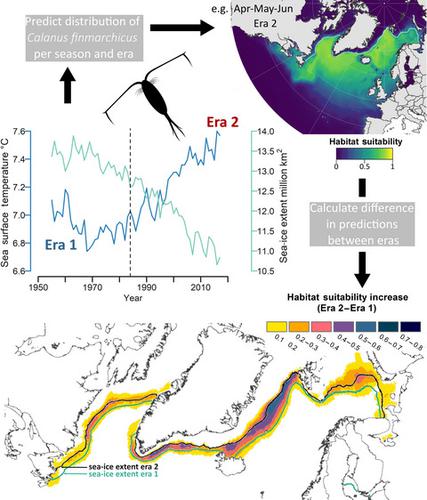当前位置:
X-MOL 学术
›
Glob. Change Biol.
›
论文详情
Our official English website, www.x-mol.net, welcomes your
feedback! (Note: you will need to create a separate account there.)
Modelling the biogeographic boundary shift of Calanus finmarchicus reveals drivers of Arctic Atlantification by subarctic zooplankton
Global Change Biology ( IF 10.8 ) Pub Date : 2021-10-15 , DOI: 10.1111/gcb.15937 Jennifer J Freer 1 , Malin Daase 2 , Geraint A Tarling 1
Global Change Biology ( IF 10.8 ) Pub Date : 2021-10-15 , DOI: 10.1111/gcb.15937 Jennifer J Freer 1 , Malin Daase 2 , Geraint A Tarling 1
Affiliation

|
Biological communities in the Arctic are changing through the climate-driven encroachment of subarctic species. This “Atlantification” extends to keystone Calanoid copepods, as the small-bodied Calanus finmarchicus increases in abundance in areas where it overlaps with larger Arctic congeners. The environmental factors that are facilitating this shift, whether related to optimal conditions in temperature or seasonality, remain unclear. Assessing these drivers at an Arctic-wide scale is necessary to predict future ecosystem change and impacts. Here we have compiled range-wide occurrences of C. finmarchicus and a suite of seasonal biophysical climatologies to build a boreo-Arctic ecological niche model. The data set was divided into two eras, 1955–1984 and 1985–2017, and an optimized MaxEnt model was used to predict the seasonal distribution of the abiotic niche of C. finmarchicus in both eras. Comparing outputs between eras reveals an increase in habitat suitability at the Arctic range edge. Large and significant increases in suitability are predicted in the regions of the Greenland, Labrador, and Southern Barents Seas that have experienced reduced sea-ice cover. With the exception of the Barents Sea, these areas also show a seasonal shift in the timing of peak habitat suitability toward an earlier season. Our findings suggest that the Atlantification of Arctic zooplankton communities is accompanied by climate-driven phenology changes. Although seasonality is a critical constraint to the establishment of C. finmarchicus at Arctic latitudes, earlier sea-ice retreat and associated productivity is making these environments increasingly favorable for this subarctic species.
中文翻译:

Calanus finmarchicus 的生物地理边界移动建模揭示了亚北极浮游动物导致北极大西洋化的驱动因素
由于气候驱动的亚北极物种的入侵,北极的生物群落正在发生变化。这种“大西洋化”延伸到了关键的 Calanoid 桡足类动物,因为小型Calanus finmarchicus在与较大的北极同类物重叠的地区数量增加。促进这种转变的环境因素,无论是与温度或季节性的最佳条件有关,仍不清楚。在整个北极范围内评估这些驱动因素对于预测未来的生态系统变化和影响是必要的。在这里,我们编译了C. finmarchicus的广泛出现和一套季节性生物物理气候学,以建立北北极生态位模型。数据集分为1955-1984和1985-2017两个时代,并采用优化的MaxEnt模型预测C. finmarchicus非生物生态位的季节分布在两个时代。比较不同时代的产出表明北极山脉边缘的栖息地适宜性有所增加。预计格陵兰、拉布拉多和巴伦支海南部海冰覆盖减少的地区的适宜性将大幅增加。除了巴伦支海之外,这些地区还显示出栖息地适宜性高峰时间向较早季节的季节性变化。我们的研究结果表明,北极浮游动物群落的大西洋化伴随着气候驱动的物候变化。尽管季节性是在北极纬度建立C. finmarchicus的关键限制因素,但较早的海冰消退和相关的生产力使这些环境越来越有利于这种亚北极物种。
更新日期:2021-12-13
中文翻译:

Calanus finmarchicus 的生物地理边界移动建模揭示了亚北极浮游动物导致北极大西洋化的驱动因素
由于气候驱动的亚北极物种的入侵,北极的生物群落正在发生变化。这种“大西洋化”延伸到了关键的 Calanoid 桡足类动物,因为小型Calanus finmarchicus在与较大的北极同类物重叠的地区数量增加。促进这种转变的环境因素,无论是与温度或季节性的最佳条件有关,仍不清楚。在整个北极范围内评估这些驱动因素对于预测未来的生态系统变化和影响是必要的。在这里,我们编译了C. finmarchicus的广泛出现和一套季节性生物物理气候学,以建立北北极生态位模型。数据集分为1955-1984和1985-2017两个时代,并采用优化的MaxEnt模型预测C. finmarchicus非生物生态位的季节分布在两个时代。比较不同时代的产出表明北极山脉边缘的栖息地适宜性有所增加。预计格陵兰、拉布拉多和巴伦支海南部海冰覆盖减少的地区的适宜性将大幅增加。除了巴伦支海之外,这些地区还显示出栖息地适宜性高峰时间向较早季节的季节性变化。我们的研究结果表明,北极浮游动物群落的大西洋化伴随着气候驱动的物候变化。尽管季节性是在北极纬度建立C. finmarchicus的关键限制因素,但较早的海冰消退和相关的生产力使这些环境越来越有利于这种亚北极物种。











































 京公网安备 11010802027423号
京公网安备 11010802027423号